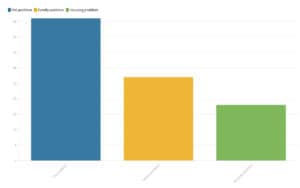Is positive reinforcement training strict enough for my difficult dog?

Positive reinforcement does not mean there are no rules or boundaries. The focus of positive reinforcement is teaching and rewarding appropriate behaviors, while at the same time utilizing safe, cruelty-free, effective methods for handling undesirable behavior of all levels. It is not about being strict. It is about proper communication and consistency.
There is a misconception that positive reinforcement trainers are doormats and “treat pushers” who over-reward and use too much coddling to be effective.
Regarding reward, it is helpful to think of it in this context: do you have a job? Do you like getting paid for your job? Would you keep working as hard if your boss cut your pay, or told you to work for no pay? A dog gets paid in rewards for doing a good job, just like any human does. While many trainers use food as a reward, it is actually the goal of positive reinforcement to fade out the use of food so that animals perform well with other types of reward, such as praise, attention, or play. And, as you can see from our post “………….”, positive reinforcement training has the best track record for teaching, learning, and retaining skills and training.
Regarding being doormats, positive reinforcement trainers do, in fact, establish boundaries with animals! Boundaries are an important way to manage and explain to an animal what is appropriate and what is not.
For most dogs, attention is the most valuable resource. All attention is reinforcement, no matter if it is praise, scolding, or just one second of eye contact. Therefore, when dogs act up and other methods of redirection have failed, positive reinforcement trainers are experts at removing attention. When dogs see that they are not getting the response they expected, they often stop doing whatever it is that is not getting attention.
A perfect example is when I was working with a young puppy on all sorts of exercises. Even with a high rate of reinforcement and activity, he would get whiny and even start barking and jumping up at me if I stopped playing with him for even a few seconds. So whenever he would start whining or barking, I would stand up, silently walk into the bathroom, and close the door. I only opened it again when he stopped whining or barking. He stopped within a few days once he realized that his actions led to me removing my attention.
When dogs pull on leash, a positive reinforcement trainer will work on specific, fun leash exercises to teach a dog how to walk properly on a leash, without aversives like choke or prong collars, leash popping or yanking, or dragging. However, when pulling does end up happening, the trainer will stop walking until pulling stops. That’s it. No pain, no coercion. Just the simple message of, “If you pull, we don’t go where you want”.
Likewise, if a puppy starts using their teeth on me, I will place them in a play pen for a minute (or until they are calm), and completely ignore them. They can’t run free and cause destruction, but they are not being restrained, coerced, or punished in a harmful way. It is simply a mechanism for safely removing attention.
It is always best to begin by working with reinforcement of a preferred behavior, and moving into attention removal as a last resort. For puppies who bite, I try redirecting first, work on handling exercises, teach alternative behaviors, etc…But if teeth hit the skin at any point, attention is removed. As I have pointed out, dogs learn best with positive reinforcement. Removal of attention is, strictly speaking, not positive reinforcement, but neither is it use of force or coercion, and it is necessary to set such harm-free boundaries for positive reinforcement to be most effective.







